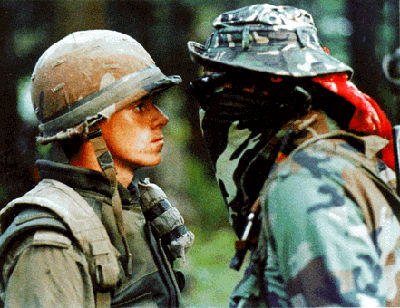In the summer of 1990, a resistance occurred in Kanesatake, Quebec. Nearby is a town called Oka. This event has many names – the Oka Crisis, the Kanesatake Resistance, and the Mohawk Resistance. The main participants were Kanyen'kehà:ka (Mohawk) protesters, the Quebec police, the RCMP, and the Canadian Army. It started when members of the Kanyen'kehà:ka community started protesting the expansion of a golf course and the building of townhouses. An Indigenous burial ground was on this land. The situation quickly became violent. One police officer was killed. He was a corporal in the Sûreté du Quebec. After this, the Canadian Army went to Kanesatake. The expansion ultimately was stopped. The federal government bought the disputed land. The resistance ended in late September. However, the land was not transferred to the Kanyen'kehà:ka. The resistance had lasting repercussions.
This article is a plain-language summary of Kanesatake Resistance (Oka Crisis). If you are interested in reading about this topic in more depth, please see our full-length entry, Kanesatake Resistance (Oka Crisis).

Historical Background
The land around Oka and Kanesatake has been disputed for a long time. As early as the 1760s and into the 1910s, the Kanyen'kehà:ka (Mohawk), the British government, and Roman Catholic church struggled over the land. In 1851, the Kanyen'kehà:ka asked the government to recognize the land as theirs. They were ignored. They were met with the same reaction by various levels of government for over a century. For example, their land claims in 1975 and 1977 were rejected.
Leading up to the Crisis/Resistance and First Events of the Crisis

In 1989, the mayor of Oka announced an expansion of the golf course and the building of townhomes. The Kanyen'kehà:ka (Mohawk) were not told about this before. The Kanyen'kehà:ka around Kanesatake protested. Plans for construction continued though. To stop this, a group of Kanyen'kehà:ka created a barricade to stop the construction. Soon after, Kanyen'kehà:ka from Kahnawake and Akwesasne joined the protests. Another group called the Mohawk Warrior Society also joined.
The town of Oka asked the Sûreté du Quebec (SQ) to take down the barriers. When they came, they used tear gas and concussion grenades. The goal was to scatter the protesters. After this, shots were fired on both sides. Marcel Lemay, an SQ officer, was killed. The SQ retreated.
A Growing Resistance

Following the violence, a growing number of individuals joined the protests and it expanded. Kanyen'kehà:ka (Mohawk) from the Kahnawake Reserve blockaded the Mercier Bridge. The bridge is used by commuters to get to and from Montreal. Tensions became very high at this point. Non-Indigenous people in and around Montreal were very upset.
Involvement of the Canadian Army
The premier of Quebec, Robert Bourassa, asked the federal government to send the military to bring about an end to the resistance. Approximately 4,000 soldiers were sent. After the military arrived, tensions grew tremendously. It became very tense on Tekakwitha Island. This island is near Kahnawake. The police and soldiers fought with the Kanyen'kehà:ka (Mohawk). There were many injuries on both sides.
Legacy of the Kanesatake Resistance
The Kanesatake Resistance garnered national attention. Canadians were divided over the issues involved. Some supported the Kanyen'kehà:ka (Mohawk) while others did not. One very important consequence of the events was the creation of the Royal Commission on Aboriginal Peoples. This, in turn, made Canadians more aware of the Indigenous peoples in Canada and the issues that affect them. One of these issues is land claims. It also supported the creation of nationwide Indigenous movements. The Kanesatake Resistance was a turning point in the history of Indigenous/Settler relations.

 Share on Facebook
Share on Facebook Share on X
Share on X Share by Email
Share by Email Share on Google Classroom
Share on Google Classroom

